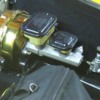OK. I'm back after getting reassurance that I'm not too small after all. Cost me a few bucks and she probably would have told me anything I wanted to hear anyway since I was paying?

I went and bought a real tape measure and it isn't missing any digits.
My front Pantera rotor measures 11.060" od. The 68 Mustang according to Centric is 11.29" od.
The rear Pantera needs to be taken apart and is difficult to get without brake calipers. Seems to have a 5-5/8" radius, until it comes apart to verify.
What started all of this is that I just finished a project on my 68 Shelby GT350 on which I installed the front brake system that was used on the 68 Shelby Trans-Am Mustang race cars (with 15" rims) and the 69 Boss 302 Trans-Am cars.
That system used what the racers refer to as the "big Lincoln" brakes. For 15" wheels, many Ford racers consider it to be the ultimate.
They originally used the Lincoln/T-bird front rotors and 4 piston brake calipers.
The rotor over the years has gone from 12"od to the now standardized (because it fits all of the big Ford cars from 65-69) 11.73" od rotor. It is 1.24" thick and vented.
Because it is out of the "Ford family" it fits the 65-73 Mustang hubs which are also used on the big Fords. The Pantera has a Ford family front hub, and it fits it also.
The 70 Mustang got an increase in the size of the spindle od on both the small and large bearings. The large bearing went from 32mm id on the 65-69 cars to 35mm on the 70 and up. As such it is a cheap insurance for a race car to switch the spindles over to the large race spindles.
Since when you look at the engineering cross overs here, I was investigating if the Pantera front spindles followed suit with the Mustangs.
What I was investigating was how simple or complicated the adapter would need to be to swap this "trans-am" braking system over to the Pantera.
Enough explanation?
Now for those of you that will immediately jump up and yell "Heretic", I say "bless you my son".
The Wilewood rotor with aluminum hat that would be the substitute for the Tbird rotor, is virtually the same weight. Most of the weight is caused by the thickness of the rotor which is the same. So don't go screaming about the weight differences, because there is virtually no difference, or not enough to argue over? Certainly if you compare the price differences between these two set ups, the "Big Lincoln", becomes very attractive and many would be willing to overlook the fact that the new aftermarket would be closer to the ultimate?
The Lincoln caliper true is iron and not as fancy as the aluminum aftermarket. It is four piston and the pads are nice and large. Porterfield R4S pads are stocked because of the commonality with the set up.
But in all honesty, wearing all that anodized aluminum like "BREMBO!", with IT'S SEEMIMNGLY neon light logo names on them make me feel like a Tiajuana pimp.
Anyway, what came out of this is that the 68 Mustang front rotor (without the cast in hub) is really a good substitute for the stock front Pantera rotor. Transfer right over to the P front hub.
Lots, lots cheaper then the P car piece from Wilkinson too.
Now the rear is another story. Still just looking at that one.
It does look like the Tbird rotor fits for od and hub alignment but the thickness doesn't look like it will work with the stock rear P car calipers?
I've come to the conclusion that the tiny stock rear P pad was used on that big rear rotor to eliminate necessity for a proportioning valve, front/back, by Detomaso.
Now, so far I would say that the T-bird vented rotor od will transfer over to the hub assembly in the rear, but the entire P rear caliper causes all sorts of substitution limitations?
What is the point of putting the rotor in, except for a cheap substitution to the stock rotor, if the stock P rear pads are so small?
Irregardless, I think that an inline proportioning valve is going to be required if the rear is played with at all.
Considering how hard you will need to test the car to adjust it to, you literally will need a race track all to yourself to work on that adjustment, so for me, on all of this, the jury is still out.
I am looking at the Volvo S60 R calipers as an alternative in both locations too. I suspect though that they would be a better swap on a larger rotor because of the stock size of the Volvo rotors at 15.9" od, and the probable interference with the pads on a smaller rotor?
They might be a really good swap over on a big wheel Pantera though?
At this point I really am wondering what the factory race cars did for brakes back when... You can't convince me that they ran the stock production set up?
OK. Happy bickering now gentlemen. I really know how to stir it up, huh?




